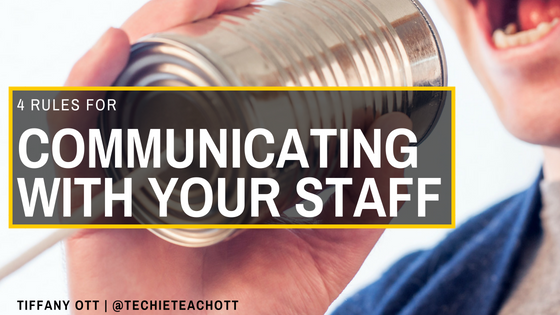How do you communicate with your staff?
If you spend any significant amount of time with educators, you know that we value relationships. Building strong relationships with students is critical for creating a learning environment that is positive, effective, and impactful.
In real estate, location is everything, right? Location, location, location! In education, relationships are everything. Relationships, relationships, relationships!
And this goes for every part of a school’s internal network. Teachers need a good relationship with students. Teachers need a good relationship with the principal. Principals even need a good relationship with the company who go their cleaning services because, at the end of the day, the school needs to be clean! It doesn’t matter where in the chain of command they are, if a good relationship isn’t formed, it can be detrimental.
A staff that feels heard is a staff that can help build the kind of school that changes lives. Share on XJust as we emphasize positive relationship building between teachers and students, we must also consider the relationships we build between adults. The way we speak to, communicate with, and share information with our staff can determine the course of the school year. Every single interaction you have with the staff at your school impacts the culture. You can model the positive interactions you want teachers to have with students through the positive interactions you have with your teachers.
If you follow these rules, you will be well on your way to that goal.
Rule #1: Shut Up And Listen.
The best way to communicate is to listen. Don’t talk. Don’t email. Don’t write a memo. Simply listen.
Many administrators are problem solvers and idea creators. You see a problem, you have an urge to fix it. You probably also have a few hundred ideas of how to fix it swimming around in your head. Our instinct is to react with solutions, plans, ideas. But, I am here to tell you that isn’t going to work.
The first step in communicating successfully with staff is to simply listen to what they have to say. If you are in a meeting with some of your teachers, let them lead. Let them speak. Don’t dominate the conversation with your ideas. Your idea may be the one that ends up being used, but you’ll be amazed at the ideas that will come when you let your staff work on a problem.
Adult learners are similar to young learners in many ways. When teachers design lesson plans, they should have the goal of minimizing teacher talk time. The more students talk, collaborate, and problem solve, the more effective learning takes place. Just as you want your teachers to step back and stop dominating the conversation, so should you.
One quick trick to help you with this? When a teacher is talking to you, whether you ran into each other in the hall or they are in your office with a concern, mentally count to five (slowly) after they finish a sentence. This gives them the opportunity to share more with you. It is like the wait time we encourage teachers to use. Make it a habit by practicing, practicing, practicing. Try it first with a friend or family member so you can get comfortable with the process. Then, introduce it into your daily interactions with your staff. You will be amazed at how those five seconds can make a huge difference.
[scroll down to keep reading]Rule #2: Don’t Waste Their Time.
When you work with teachers from across the world, you hear a common refrain time and time again. Wasted time. Useless meetings. Unnecessary conversations. Be picky about what you say and in what format you say it. If information can be communicated with an email, then communicate it with email! Don’t waste the one staff meeting you have a month with housekeeping information.
Some of you may be thinking, “But my teachers never read their emails! It doesn’t matter what I send them electronically, they don’t seem to pay attention to it.”
If you have a problem with teachers not reading emails, then you have a problem with teachers not reading emails. You don’t have to turn that into a problem of unnecessary, time-wasting meetings.
Consider this: If students were given a study guide in preparation for a test and they did not complete it, does it mean that the teacher should stop giving study guides? Not necessarily. The teacher should take steps to talk to students about WHY they didn’t do the study guide. They would gather feedback on how they can make the study guide more effective. They could set more clear expectations and follow through on those expectations. They certainly shouldn’t just stop using study guides.
Is the information you are trying to communicate low on the Depth of Knowledge scale? If the thinking your staff needs to do to understand the information is on level 1 (recall), then you absolutely shouldn’t have a meeting about it. Communicate it digitally and set expectations for how teachers will use these digital communications.
Rule #3: Be Present.

You don’t have to go far to hear someone complaining about how modern technology is robbing us of human interaction. Now, don’t get me wrong, I love tech! I think it is incredibly powerful in education, and allows us to connect in ways we never could 10 or 20 years ago. BUT, there is a time and a place for computers, tablets, and cell phones.
When you are having a conversation with a member of your staff, whipping out your phone or writing an email on your computer will shut down communication faster than you can click send. If your eyes are on a screen, they aren’t looking at your staff member. One of the most powerful ways to increase the effectiveness of communication is to maintain eye contact. So, look your staff in the eye. Don’t take your phone out of your pocket. Resist that urge to multitask!
When you make a conscious effort to be fully present in the conversation with your staff, they will see you as more authentic. You will seem more willing to listen and collaborate. It does not matter that you were already willing to listen and collaborate before. What matters is that your staff believes that they are more important than the 1,543 other things you have to accomplish that day.
Rule #4: Say What You Will Do. Do What You Say.
One of the biggest impacts on positive communication with anyone is trust. Your staff has to believe that they can rely on you. Before you start implementing solutions or sending emails or introducing new policies, you must show the people you work with that they can count on you. When someone trusts their leaders, they will work harder, achieve more, and enjoy the work they do!
How do you build this trust?
First, be clear, specific, and deliberate when you offer ideas or solutions. After you have taken the time to listen to your staff, you can finally start offering ideas and solutions.
Consider this example:
Some teachers are upset because the transition from lunch back to class is not going well. Students often come back to class later than the scheduled time and there seems to always be some kind of drama that happened during lunch. This is a common issue in schools around the world!
One response to this problem is to say, “Thank you for letting me know. I will look into it.”

I hate to break it to you, that is a useless response. To your staff, it says, “I’m probably not going to do anything about this after we walk away from each other.” Try this one on for size instead. It was crafted using the principles of SMART goal writing. (Specific, Measurable, Achievable, Relevant, and Timely).
“I will take some time today after lunch to talk to Mrs. X (lunch aid) about the situation. Perhaps we can have the lunch aids start the clean-up process a few minutes earlier so that students can get back to class on time for learning. It will probably take a little while to get into the habit of the change, so let’s meet back up in two weeks to revisit the idea. How about we sit down Monday the 24th to talk about it. Does 7:30 work for you? If not, I could also meet at 10:00 or 2:15. If you could keep track of what time students return to your class after lunch for these two weeks, that could give us some good information to help problem solve if this plan doesn’t work.”
Whew! That is a much more complex and lengthy response! You can see how far that conversation goes in helping build trust while solving a problem. It lays out what you’re going to do. The next step is to then follow through and do what you said you were going to do! This kind of communication can transform the relationships in your school. It takes practice, but is well worth the effort!
Relationships, relationships, relationships.
If you take the time to be purposeful in your communication, you will be doing the single most important thing towards building a positive school culture, building relationships! A staff that feels heard and acknowledged is a staff that will relentlessly pursue better teaching and learning. It is a staff that will worry less about how long the staff meeting is. A staff that feels heard is a staff that can help build the kind of school that changes lives.
Change is not easy! If you are guilty of breaking any of these four rules, it’s OK to feel a little overwhelmed right now. Choose one. Start somewhere. Set a goal to follow one new rule each month of the school year. By May, you will be reaping the benefits of positive, effective communication.



